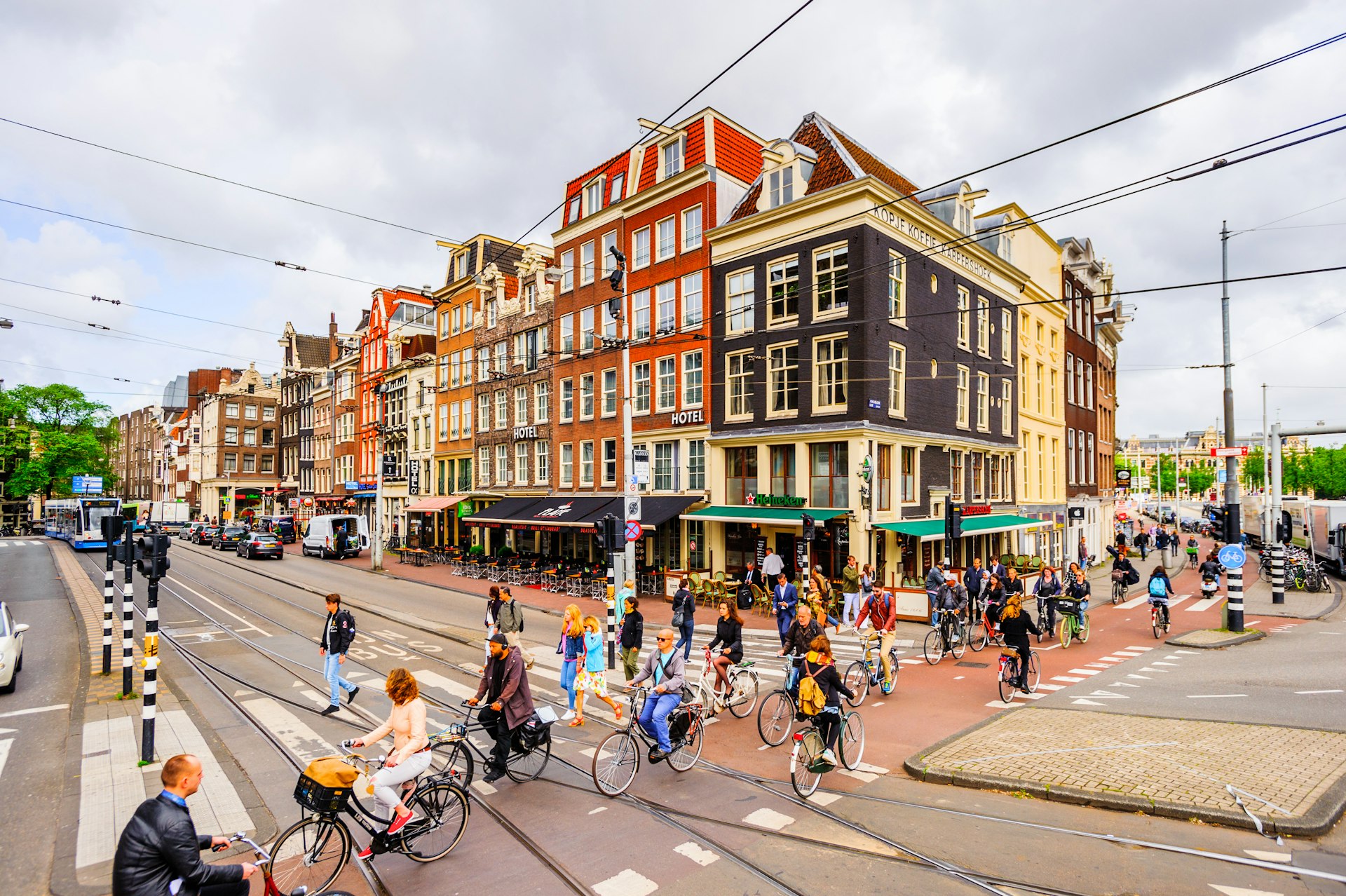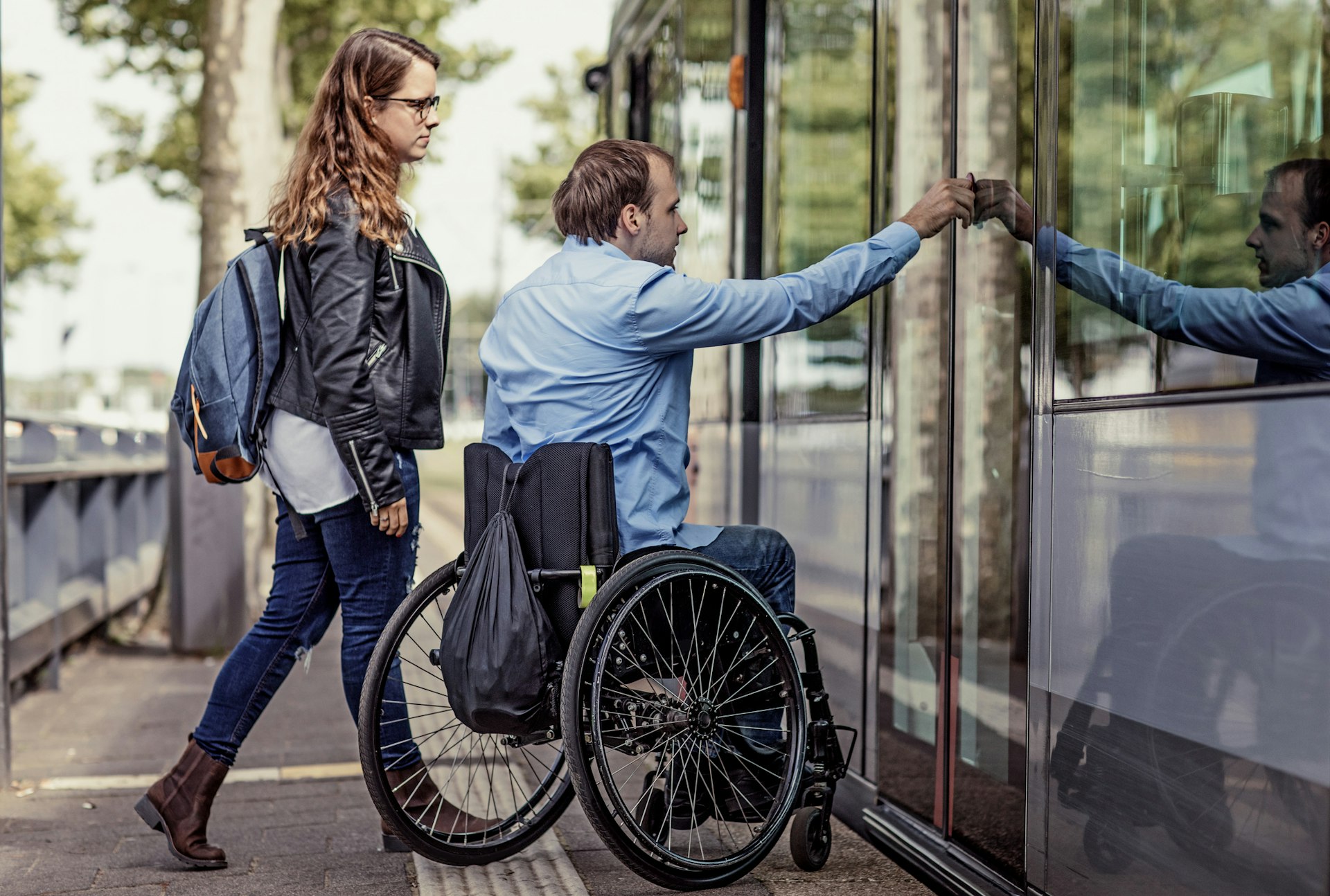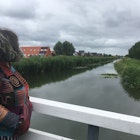Navigating the Netherlands is a breeze. Its compact size means there are no domestic flights and the efficient, highly integrated public transport network of trains, buses and ferries covers all corners of the country.
The flat terrain and extensive bicycle paths lacing the country also make it possible to travel around entirely on two wheels. Here’s what you need to know to get moving.
Plan your public transport journey
First things first: if you’re taking public transport anywhere in the country (including within cities), journey planner 9292.nl calculates the most efficient journey for you in real-time, notifying you of any disruptions and providing a cost estimate. It’s available online or you can download the app.

Trains are ideal for covering distances quickly
The backbone of the Netherlands’ public transport is its superb rail network. Most lines, including the major routes, are operated by the national train company, NS (Nederlandse Spoorwegen), which handles all scheduling and fares. Dutch trains are modern and comfortable, and the service is reliable and frequent across the country.
In addition to regular services, high-speed Intercity direct trains operate between Amsterdam, Schiphol Airport, Rotterdam and Breda, with a supplement between Schiphol and Rotterdam. A supplement is also charged for domestic travel on the Amsterdam-Utrecht-Arnhem route aboard ICE International trains.
Medium and large railway stations have a full range of amenities but smaller stations often have no services at all, not even a staffed ticket window (tickets, if not prepurchased, are available at vending machines; more information on ticketing later).
Bringing a bicycle on NS trains is possible in off-peak hours (9am to 4pm and 6.30pm to 6.30am Monday to Friday, plus all day on weekends, public holidays and during July and August). In addition to your fare, you’ll need to pay €7.50 for a fietskaart dal (off-peak bicycle ticket).
Buses are handy for regional explorations
Part of the Netherlands’ integrated transport system, buses are good for short distances and filling the gaps in the rail network. This is especially true in parts of the north and east of the Netherlands where trains are infrequent or nonexistent.
Ferries offer scenic voyages in some areas
Ferries ply the waters in a number of local areas. You can travel from the mainland to the island of Texel and the Frisian Islands, and some inter-island ferry services link the most populous islands in the summer season.
In Zeeland, in the Netherlands’ south, passenger ferries operate on the Westerschelde. The Waterbus is a fast ferry service that operates between Rotterdam and Dordrecht and to destinations such as Kinderdijk’s historic windmills. Other minor services also provide links across the country’s canals and waterways.

Cycling is an easy and exhilarating way to explore the Netherlands
To roll like the Dutch do, hop on a fiets (bicycle). With its flat, often beautifully scenic landscapes, mild maritime climate and outstanding cycling infrastructure, the country is prime for exploring on two wheels. You’ll find rentals at most train stations and in towns and cities countrywide.
For short distances and day trips, the fietsknooppuntennetwerk (cycle junction network), made up of knooppunten (junctions, i.e. “nodes”) where cycle routes converge, is easily navigable. Route-finding apps include the Fietsersbond Routeplanner.
For long-distance cycling journeys, check out the Landelijke Fietsroutes (LF routes), which continue to expand and are downloadable on a handy app. Helmets aren’t mandatory in the Netherlands but can be a literal life-saver; you can hire them from bike rental outlets.
Driving lets you reach out-of-the-way locations
The state-of-the-art Netherlands infrastructure means smooth, easy-to-navigate roads. Traffic can be heavy on major freeways and around the bigger cities, however, and parking can be scarce and expensive (and perilously close to canals).
Parking meters typically require you to type in the license plate and pay by credit card or a mobile app. Around bigger centers, a “Park & Ride” car park is generally your best and cheapest option. Always be mindful of wide bike lanes when driving and watch out for cyclists!
How to buy public transport tickets
Tickets for the Netherlands’ public transport system are charged according to the distance traveled and can be purchased in several ways.
E-tickets (printable) and mobile tickets (downloadable to your phone/NS app) can be purchased from NS online – you access the gates by scanning a QR code on your phone. Buy carefully as they aren’t refundable. An alternative is buying tickets on the Trainline website, which adds a booking fee but permits refunds up to the day before travel.
For single trips, you can buy a disposable OV-chipkaart (which incurs a €1 surcharge per journey on top of the standard fare). For multiple journeys, you can buy a reusable OV-chipkaart or use OVpay (while a new digital OV-pas is being rolled out this year, the OV-chipkaart system will remain in use until at least 2025).
With an OV-chipkaart or OVpay, it’s important to hold it against the reader to “check in” when entering transport and “check out” when exiting (or forfeit your deposit).
A reusable OV-chipkaart costs €7.50 and is valid for five years. You then load it with credit at ticket machines. There’s a minimum €10/20/4 for buses/trains/other forms of transport such as trams, which is held as a deposit during your journey and the balance refunded afterward. These reusable cards are automatically activated if bought from NS stations, otherwise, you may need to activate it for “pre-paid travel without NS subscription” at train station ticket machines or service desks.
An alternative to a physical OV-chipkaart is OVpay, using a contactless debit/credit card (Maestro, V PAY, Mastercard or Visa only) to “check in” and “check out” of your journey. The upside is saving the cost of the reusable card or disposable card surcharge, the downside is only being able to track the fare in your card/bank statement (tallied and charged once per day).

Accessible transportation in the Netherlands
The Netherlands is committed to making all of its public transport accessible for people living with disabilities in the near term and is making sound progress. Already, most buses, ferries, trams, metros and trains have wheelchair ramps, wide-opening doors and/or level platforms, designated wheelchair places and priority seating, and wheelchair-accessible onboard bathrooms for longer services.
National train operator NS offers travel assistance at over 100 stations throughout the Netherlands. In smaller destinations, it’s worth checking with tourism authorities before you travel to assess transport suitability.
Tourist passes can be a straightforward, money-saving option
A simple and often cost-effective way to use the Netherlands’ public transport system is with a tourist day ticket.
A Holland Ticket, despite its name, covers the whole of the Netherlands (not just the provinces of North and South Holland). The standard Holland Travel Ticket (€70) gives you unlimited travel by train, bus, tram and metro any day of the week, including peak hours. A cheaper off-peak Holland Travel Ticket (€48) can be used on weekdays before 6.30am and after 9am, and all day on weekends and public holidays. It’s sold at NS ticket machines, service desks and online.
If you’re sticking to one area, look for tickets such as the Amsterdam Travel Ticket or wider Amsterdam & Region Travel Ticket (including trains to/from Schiphol airport), or the Tourist Day Ticket for South Holland, around Rotterdam, Delft, Den Haag and Leiden, covering all transport including Waterbus services.
Keep planning your trip to the Netherlands:
Use your tourist day ticket to explore our pick of the best places to visit
Check out the Netherlands' social calendar and pick the best time for your visit
Start planning your must-see list now with our round-up of the top things to do in the Netherlands











